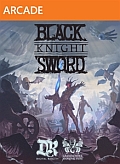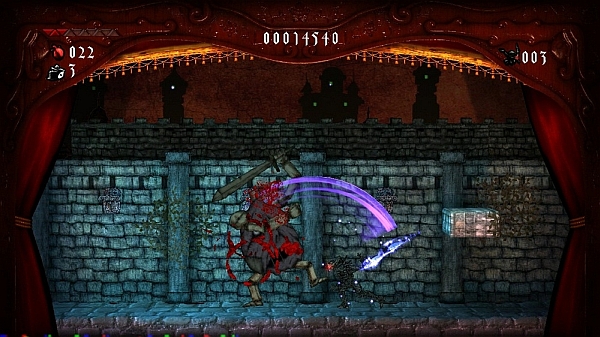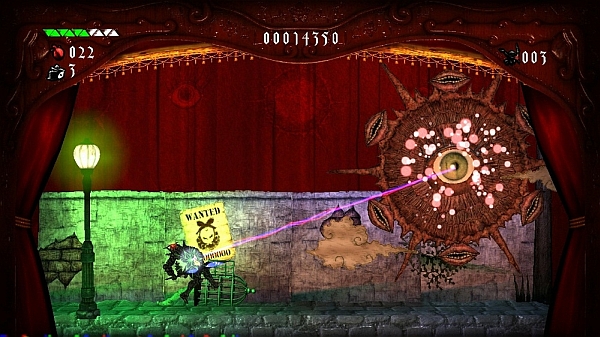
When playing, or in this case, reviewing, a Grasshopper/Suda 51 game, one must not only be prepared to go down the rabbit hole into Weirdville, but also locate the rabbit hole within the rabbit hole to enter an even more bizarre world. Multiple times during a playthough, you’ll find yourself saying, “What the hell is going on here?” Luckily, though, you’re smiling the entire time. Grasshopper’s latest offering, Black Knight Sword, continues this tradition, taking you on perhaps the strangest journey you’ll ever take.
Platforms: PS3, Xbox 360 (Version Played)
Publisher: Reverb Publishing
Developer: Grasshopper Manufacture, Digital Reality
Genre: Hack-n-Slash Rehash
Release Date: December 11, 2012
ESRB Rating: Mature
 In classic Suda 51 fashion, Black Knight Sword doesn’t tell its story like a typical video game. Instead, the game is presented as a strange mishmash of theatrical play and cut-out diorama. If Paper Mario and Ghosts n’ Goblins had a kid, and that kid then had a really bad acid trip, Black Knight Sword would be the result. The story, and game itself, plays out on a stage, with curtains on the sides. While I appreciate the theatrical feeling the setting provides, I would much rather prefer to turn off the curtains. The camera is zoomed in enough as is, and having those obstructions (because let’s face it, that’s what they are) in your way certainly make a difficult game even harder.
In classic Suda 51 fashion, Black Knight Sword doesn’t tell its story like a typical video game. Instead, the game is presented as a strange mishmash of theatrical play and cut-out diorama. If Paper Mario and Ghosts n’ Goblins had a kid, and that kid then had a really bad acid trip, Black Knight Sword would be the result. The story, and game itself, plays out on a stage, with curtains on the sides. While I appreciate the theatrical feeling the setting provides, I would much rather prefer to turn off the curtains. The camera is zoomed in enough as is, and having those obstructions (because let’s face it, that’s what they are) in your way certainly make a difficult game even harder.
The story revolves around two sisters, whose sibling rivalry was so bad it even continued in the afterlife. You play as the Black Knight, a physical manifestation of the dark sister, tasked with battling the minions of the light sister on a quest to defeat her once and for all. The art style in Black Knight Sword is definitely unique. The characters show that Suda 51 flair, from the strange and silly to the outright horrifying (werewolf boss, I’m looking at you). One of the best parts of the game is the narrator, whose Vincent Price-esque voice adds a sense of malevolence to your journey.
Black Knight Sword blends many different genres together, but at its core is a 2D platformer. You move from left to right, killing enemies until you reach the end boss. Take out the boss, and you move on to the next level. Your main weapon is the titular sword, which you use to eviscerate your enemies. In addition to your basic jabs and swipes in eight directions, the sword also has a strong attack which can be charged, shoots blasts of energy when your health is full (sound familiar?), and also performs a super attack when a hadoken (down, down-forward, forward + attack) input is entered.

Your sword is not your only weapon, however. The dark sister accompanies you on your quest, and can be used to attack enemies from afar and to turn on invisible blocks to help you reach out-of-the-way areas. Scattered throughout the levels are microwaves (it’s a Suda 51 game, don’t ask) which contain health, 1UPS, and hearts (the game’s form of currency). You use the hearts to upgrade the knight’s health and strength, as well as the dark sister’s power.
While at first it may seem like your typical sidescroller, Black Knight Sword really shines once you realize that you’re playing a love letter to video games of yesteryear. During my playthroughs, I noticed references to Mega Man, Contra, Duck Tales, Legend of Zelda: Ocarina of Time, countless shoot-em-ups, and the aforementioned Ghosts n’ Goblins. Outside of the realm of video games, I cracked up when I saw references to Monty Python, and Looney Tunes’ own Rubber Band. Take a listen and you’ll see what I mean when you purchase an upgrade in the game.
Another aspect of classic gaming that Black Knight Sword “lovingly” resurrects is the extremely frustrating difficulty. Playing the game on Easy is not difficult at all: the enemies go down in a few hits, and bosses are a cakewalk. The platforming sections are usually the hardest part. However, once you make the jump to Normal – or heaven forbid, Hard – you really are in for a challenge. Not only do enemies take a lot more hits to die, but there are also multiple types. The Goomba-esque walking faces now jump at you after the first hit, rush you at an extremely high rate of speed, and have spikes on their heads so you can’t pogo-jump on their heads. Bosses, while still following the same pattern that you need to memorize and exploit, deal more damage and generally require a lot more effort. Hell, there’s even an Achievement for dying fifty times. If that isn’t shoving the difficulty in your face, you obviously aren’t paying attention.

Luckily, the game offers a New Game+ option, so you can carry over all your upgrades into the subsequent playthrough. And you’ll need that second playthrough to get the true ending to the game – just like Ghosts n’ Goblins. The fun doesn’t end there, though: you can also play the brutal Arcade Mode, which lowers your energy and gives you only three lives to make it through the entire game – just like many of the arcade games that Black Knight Sword is based upon. The game also includes a Challenge Mode, in which you are graded on how quickly you can complete mini-levels. These levels vary, from making next-to-impossible jumps to taking on boss characters with a set amount of health. It’s a fun addition to the main story that gives a more casual contrast to the hardcore game.
Black Knight Sword feels like it was made just for me, and many others who grew up playing those impossible games in the eighties. Even better, it carries with it Suda 51’s unmistakable charm, humor, and eccentricity. Whether you are looking for some quality old-school platforming or an intense challenge that is sure to test the limits of your sanity, Black Knight Sword is a sure bet. Just make sure to purchase a warranty for your controller.

Review Disclosure: A review copy of Black Knight Sword was provided by Reverb Publishing for the purposes of this review.







